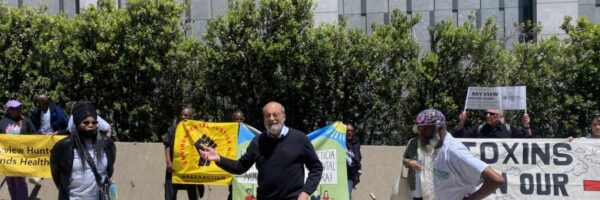
Proposed rule could protect 36 million workers from hazardous heat
By Shannon Kelleher
As dangerous heat waves sweep the US, the Biden administration this week announced a first-of-its-kind proposed rule that could help protect about 36 million workers from heat-related deaths and injuries.
If finalized, the safety standard, proposed July 2 by the Department of Labor’s Occupational Safety and Health Administration (OSHA), would require employers to develop plans to address workplace heat hazards and to put in place requirements for rest breaks and access to shade and drinking water.
The announcement came as the Environmental Protection Agency (EPA) released a new report on the impacts of climate change on health and the environment in the US, revealing that almost 1,000 workers died from heat exposure between 1992 and 2022, about one-third of which were construction workers. The report also found that the average number of heat waves increased from two per year in the 1960s to six per year in the 2010s and 2020s.
“Workers all over the country are passing out, suffering heat stroke and dying from heat exposure from just doing their jobs, and something must be done to protect them,” Doug Parker, Assistant Secretary for Occupational Safety and Health, said in a press release. The proposal marks “an important next step in the process to receive public input to craft a ‘win-win’ final rule that protects workers while being practical and workable for employers,” said Parker.

US failed to clean up radioactive Superfund site, lawsuit claims
By Shannon Kelleher
The US government has failed dangerously in its duty to clean up a radioactive former naval shipyard in San Francisco, jeopardizing the health of community members for decades and potentially putting hundreds of thousands of people at risk if plans to turn the site into a residential area materialize, alleges a lawsuit filed on Friday.
The lawsuit, which was filed in the US District Court for the Northern District of California by the group Greenaction for Health and Environmental Justice, alleges that both the Navy and the US Environmental Protection Agency (EPA) violated the federal law that governs Superfund site cleanups known as the Comprehensive Environmental Response, Compensation, and Liability Act (CERCLA).
The Navy has not properly characterized the full extent of the contamination at the Hunters Point Naval Shipyard, according to the complaint, and failed to follow through on its promise to retest all the soil that was improperly remediated by a former contractor, Tetra Tech.
The Navy has also failed to account for how rising sea and groundwater levels, driven by climate change, may exacerbate contamination risks for vulnerable neighborhoods nearby, the lawsuit alleges.
“Our community is sick and tired of the Navy and US EPA ignoring our demands for full retesting and a full cleanup of all the toxic and radioactive waste at the Hunters Point Shipyard,” Leaotis Martin, a long-time area resident and Greenaction member, said in a press release.

Rain-fed streams lacking federal protections are vital for water quality, study finds
By Shannon Kelleher
New data supports environmental advocates’ long-held position that small, rain-fed streams make major contributions to water quality in rivers and lakes across the US.
So-called “ephemeral streams,” which only flow after precipitation falls and are not currently protected under the Clean Water Act, contribute more than half of the water discharged from US regional rivers, according to the study, which published on Thursday in the journal Science. These streams are likely a major pathway for downstream water pollution, the study concluded.
The findings back concerns that a 2023 US Supreme Court decision in the case titled Sackett v. Environmental Protection Agency (EPA) may put many US waterways and communities living downstream at risk of exposure to pollutants. The ruling effectively removed federal protections for ephemeral streams and wetlands, narrowly defining “waters of the United States” as “relatively permanent, standing or continuously flowing bodies of water.”
The study provides “some scientific confirmation that pollution would flow significantly downstream from these smaller waterways,” said John Rumpler, clean water director and senior attorney for the organization Environment America.
“That’s a really important finding,” he said. “If polluters are allowed to dump into ephemeral streams with impunity and there’s no federal recourse, then downstream water quality can be dramatically impacted.”
The Supreme Court’s move to limit the Clean Water Act has been met with alarm by environmentalists and sharp criticism from the Biden administration, with President Joe Biden saying in a statement last May that it “upends the legal framework that has protected America’s waters for decades.”
A 2022 brief filed in the Supreme Court by 45 senators and 154 House members expressed support for more limited federal control in the Clean Water Act, siding with petitioners in the then-pending Sackett v. EPA case.

Plastics producers face potential wave of lawsuits, report suggests
By Dana Drugmand
As scientific understanding and public awareness of the health and environmental harms of plastics pollution continues to mount, plastics producers and plastic packaging manufacturers could face a rising tide of lawsuits from communities and states seeking to recover damage costs, a new report suggests.
The report, released on Wednesday from the Center for International Environmental Law (CIEL), details the substantial impacts of plastic pollution and related burdens on local governments, and explains how the plastics industry could be held legally responsible for these quantifiable harms and costs.
“The plastics crisis is causing harm to individuals, to communities, and to ecosystems,” said Steven Feit, a senior attorney at CIEL and co-author of the report. “There is going to be a [rising] wave of litigation in the plastics context, particularly as the evidence and the understanding of those impacts accrues.”
States and municipalities are already pursuing litigation against major fossil fuel producers, aiming to hold them accountable for localized climate damages and costs and alleging that the oil and gas industry knew decades ago about the potential for their products to cause “catastrophic” climate consequences and yet hid those risks from the public.
Such litigation over previous other toxic harms demonstrates how states and municipalities can pursue legal avenues for redress for the impacts of plastics, according to CIEL.
The American Chemistry Council called the CIEL report a “misdirected distraction” in a statement. The industry association touted the plastics industry’s efforts to improve plastic recycling and cut waste.

California set to loan $400 million to controversial nuclear power plant
By Benjamin Purper
California will loan $400 million to utility Pacific Gas & Electric (PG&E) to keep the state’s last nuclear power plant running, according to the final budget deal between the Legislature and Gov. Gavin Newsom.
The agreement authorizes a $400 million loan from the state’s general fund to help PG&E continue operating the Diablo Canyon Nuclear Power Plant near San Luis Obispo, California, according to the California Department of Water Resources.
Diablo Canyon, which accounts for about 9% of the state’s total electricity supply, became California’s last operating nuclear power plant after the closure of the San Onofre Nuclear Generating Station in 2013. The plant has been controversial from the beginning, as some environmentalist and anti-nuclear organizations fear the plant could suffer a catastrophic failure and endanger nearby communities.
PG&E maintains that the plant is safe, citing the lack of any major accidents in its nearly 40-year history.
The loan was a point of contention in this year’s budget process. Gov. Newsom originally included it in his budget proposal to the legislature, which then cut it from their own counterproposal in June.
Legislators including Budget Committee Chair Scott Weiner raised concerns that the agreements with PG&E “do not provide the state with sufficient access to information to ensure fiscal accountability.” Weiner and other lawmakers worried that the state could never receive reimbursement for the loan, leaving taxpayers on the hook for hundreds of millions of dollars.
The new loan adds to the $1.4 billion the state authorized to PG&E in 2022 to keep the plant running until 2030. The utility had planned to fully decommission the plant by next year, but the state intervened, citing projected energy shortages.
PG&E did not respond to request for comment on the new loan.

Baby bottle makers deceived parents over dangers of plastic products, lawsuits allege
Two US baby bottle makers have been engaging in a “campaign of reckless deceit” about the dangers microplastics in their products pose to infants and young children, according to a new lawsuits filed Tuesday.
In the separate court filings, lawyers representing a small group of California parents alleged that Philips North America and the Handi-Craft Co. marketed baby bottles and plastic cups as safe for children even though they knew that when the products were heated microplastics from the containers could leach into the food and liquids being served to the children. Parents often microwave or otherwise warm bottles of breast milk or formula before serving them to babies.

Postcard from California: The human cost of living with wildfires
By Bill Walker
The toll of wildfire in California is staggering: In the last 10 years, wildfires have burned more than 13.6 million acres of the state and taken the lives of 144 people, including 15 firefighters. The state estimates property damages from the more than 93,000 wildfires in those years at nearly $250 billion.
But sobering as those statistics are, they don’t measure the full cost to Californians from living with increasingly deadly and destructive wildfires.
A new study, led by researchers from the Fielding School of Public Health at the University of California at Los Angeles (UCLA), calculated that from 52,480 to 57,710 Californians died prematurely from exposure to wildfire smoke between 2008 and 2018. The study, published June 7 in the peer-reviewed journal Science Advances, estimated the economic impact of those lost lives at between $432 billion and $456 billion.
“Climate change, forest mismanagement and an expansion of the wildland-urban interface have led to worsening wildfires across California, and with those fires come smoke pollution and increasing health impacts from air pollution exposure,” Rachael Connolly, a staff researcher at the UCLA Fielding School and lead author of the study, said in a statement. “This is the first research exploring how that chronic, long-term smoke exposure affects people across the state.”
The wildland-urban interface refers to zones where people live near forests or other undeveloped areas at greater risk of wildfire. The high cost and scarcity of housing in coastal cities is pushing more and more Californians to move inland, swelling the population in areas more likely to burn.

New test finds more than 50 common chemicals may be linked to infertility
By Lydia Larsen
Using a new testing tool, US researchers said this week they have found more than 50 chemicals that pose a strong risk to fertility, including chemicals used in plastic water bottles and other common products.
The study, published Monday in Reproductive Toxicology, detailed a newly developed method for testing chemical toxicity, a tool the researchers said is badly needed because tens of thousands of chemicals used in household and commercial products have not been evaluated for their potential toxicities towards human health.
“This data shows that we need to be acting more quickly on some of these chemicals to which people are being exposed,” said Tracey Woodruff, a professor at the University of California San Francisco (UCSF), and an author of the new study.
General fertility rates in the United States have been declining, hitting a historic low in 2022, according to the US Centers for Disease Control and Prevention.
Researchers have known that certain types of chemicals are at least partly to blame for the declining fertility, but understanding the root causes of the problem has been difficult.

Biofuels manufacturing found to be a significant source of hazardous air pollution
By Dana Drugmand
Hazardous air pollutants emitted in the manufacturing of biofuels is nearly as bad as air pollution stemming from oil refineries, and for several types of dangerous pollutants such as formaldehyde the emissions from biofuel production are far greater, a new report finds.
The assessment, which was conducted by researchers with the environmental watchdog group Environmental Integrity Project (EIP), looked at emissions generated by 275 ethanol, biodiesel and renewable diesel facilities in the United States. The researchers found that the facilities frequently violated air pollution permits while at the same time benefiting from legal exemptions and federal policy supports such as fuel-blending mandates.
As the biofuels industry continues expanding with more than 30 new facilities under construction or proposed, the industry should be seen as a threat to public health, the report warns. Stronger regulatory oversight from the Environmental Protection Agency (EPA) is needed, according to EIP.
“Despite its green image, the biofuels industry releases a surprising amount of hazardous air pollution that puts local communities at risk – and this problem is exacerbated by EPA’s lax regulation” Courtney Bernhardt, EIP director of research, said in a statement.
According to the EIP report released on Wednesday, biofuels manufacturing generated 12.9 million pounds of hazardous air pollutants in 2022. That compares to 14.5 million pounds of hazardous air pollutants emitted by oil refineries that year, according to data from EPA’s Toxic Release Inventory.
Emissions from biofuel factories were significantly higher than oil refineries for four types of hazardous pollutants – formaldehyde, acetaldehyde, acrolein, and hexane, according to the EIP report. In 2022, biofuel facilities reported releases of nearly 7.7 million pounds of hexane, over 2.1 million pounds of acetaldehyde, 235,125 pounds of formaldehyde, and 357,564 pounds of acrolein. By comparison, oil refineries that year emitted 2.6 million pounds of hexane, 10,420 pounds of acetaldehyde, 67,774 pounds of formaldehyde, and zero pounds of acrolein.

Worries in wine country: Napa Valley wrestles with chemical contamination controversy
By Shannon Kelleher
Famous for its lush vineyards and cherished local wineries, Napa Valley is where people go to escape their problems.
“When you first get there, it’s really pretty,” said Geoff Ellsworth, former mayor of St. Helena, a small Napa Valley community nestled 50 miles northeast of San Francisco. “It mesmerizes people.”
What the more than 3 million annual tourists don’t see, however, is that California’s iconic wine country has a problem of its own – one that has spurred multiple ongoing government investigations and created deep divisions among residents and business owners, with some fearing the region’s reputation and way of life may be in peril.
At the heart of the fear is the decades-old Clover Flat Landfill (CFL), perched on the northern edge of the valley atop the edge of a rugged mountain range. Two streams run adjacent to the landfill as tributaries to the Napa River.
A growing body of evidence, including regulatory inspection reports and emails between regulators and CFL owners, suggests the landfill and a related garbage collection, recycling and composting business known as Upper Valley Disposal Services (UVDS) have routinely polluted those local waterways that drain into the Napa River with an assortment of dangerous toxins.
The river irrigates the valley’s beloved vineyards and is used recreationally for kayaking by over 10,000 people annually. The prospect that the water and wine flowing from the region may be at risk for contamination with hazardous chemicals and heavy metals has driven a wedge between those speaking out about the concerns and others who want the issue kept out of the spotlight, according to Ellsworth.
“The Napa Valley is amongst the most high-value agricultural land in the country,” said Ellsworth, a former employee of Clover Flat. “If there’s a contamination issue, the economic ripples are significant.”
 EWG
EWG